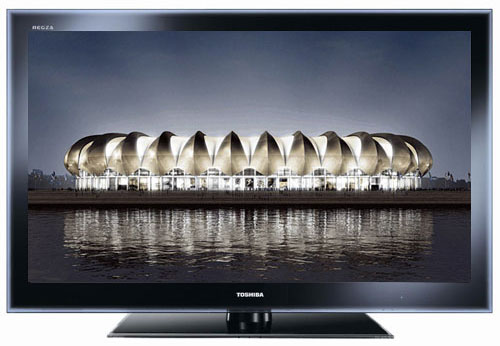LED side-lit LCD televisions… everyone’s doing it, and Toshiba have joined the party with their SL and WL series of Regza HDTVs. As the smallest member of the former, the Toshiba 32SL753B features a 1920x1080p LCD panel, Toshiba’s Active Vision 100hz motion processing, a Freeview HD (DVB-T2) tuner, and 4 HDMI inputs.
<!-- google_ad_client = 'pub-2887677957235196'; google_ad_slot = '4990177225'; google_ad_width = 336; google_ad_height = 280; //-->
The quality of Toshiba’s LCD TVs has traditionally varied by a considerable amount, with the better, non-budget offerings sometimes being some of the best performers in the LCD arena. Let’s see if the company can do great things with a side-lit LCD set in the form of the Toshiba 32SL753B.
Note: The Toshiba 32SL753B may also be advertised by retailers/etailers under the alternative model names of Toshiba 32SL753, Toshiba 32SL753D or Toshiba 32SL753DB… these terms may be used interchangeably within this review to refer to the same LED TV. While we did not test the 40-inch Toshiba 40SL753/ 40SL753B/ 40SL753D/ 40SL753DB, there shouldn’t be any significant difference in picture performance.
On first glance, you could be forgiven for mistaking the Toshiba 32SL753B for a Samsung product. The LCD panel has an unmistakable glossy (yet surprisingly non-reflective) coating, and the surrounding plastic, while thicker than Samsung’s typical designs, reminds us of that company’s mid-range LCDs (then again, there are only so many ways a company can do gloss black). On the other hand, the edges of the plastic frame feature a transparent “stippled dots” pattern, which is unique to Toshiba.

Spin the display around and, after becoming accustomed to the thinnest LED sidelit sets on the market, you could be forgiven for mistaking the Toshiba 32SL753 for a traditional back-lit model. It’s by no means bulky, but it could pass for an exceptionally skinny LCD TV.
Also noteworthy is the remote control that Toshiba bundle with the 32SL753B. It’s been redesigned, making it a welcome change from the somewhat basic-looking remote that Toshiba has been supplying with its LCD TVs for many years. Although it looks slicker and is usable enough, parts of it do feel a little on the cheap side, especially the “clicky”-feeling 4-way directional pad button.
As usual with modern HDTVs, nearly all connectivity bases are covered with the Toshiba 32SL753. There are 4 HDMI inputs in total, the obligatory Component video jacks (one set), and an analogue PC (“VGA”) input. A single RGB SCART input is included, as is a less useful Composite/S-Video capable SCART terminal. We wonder what the point of this second, non-RGB capable SCART socket is – how many VHS video recorders are seriously being connected to TVs these days? More in tune with the 21st century, there are also two USB ports, an SDHC memory card slot, and a network (LAN) connector. There is also a lowly Composite Video jack with accompanying audio inputs.
 |
| Rear/Side: 4x HDMI, VGA, Component, 2x SCART, aerial, ethernet, 2x USB, CI slot |
Ever since the company revamped the User Interface of its products, Toshiba HDTVs have featured a slightly overwhelming amount of video controls. Some of these are useful in achieving high quality images, whereas others are simply distractions.
![Toshiba 32SL753B [Picture] menu](https://www.hdtvtest.co.uk/news/wp-content/uploads/2018/04/hdtv_Toshiba-32SL753B_picture.jpg) |
| [Picture] menu |
As is often the case, the most crucial setting is the [Picture Mode], and as usual, it is “Movie” which gives the highest quality image.
![Toshiba 32SL753B [Advanced Picture Settings] menu](https://www.hdtvtest.co.uk/news/wp-content/uploads/2018/04/hdtv_Toshiba-32SL753B_adv.jpg) |
| [Advanced Picture Settings] menu |
All of the basic controls on the Toshiba 32SL753B operate as expected, but the [Advanced Picture Settings] menu warrants some investigation. In here, Toshiba promises a [3D Colour Management] feature, which must be turned on before any detailed colour adjustments can be made. The [Base Colour Management] menu allows manipulation of all six colours, with Hue, Saturation and Brightness being controllable (more on this during the Calibration section). There’s a [Colour Temperature] menu for calibrating Greyscale, and controls which allow Dynamic Backlighting and ambient light sensing systems to be enabled and fine-tuned.
A mysterious adjustment called [Black/White Level] seems to have been designed to adjust the “richness” of dark and bright areas. Upping this control adjusts the 32SL753’s Gamma tracking in a way which introduces an S-curve. If this sounds like Greek to you, think of it as a control which allows you to discard fine details in these areas of the picture in exchange for a superficially “richer” image. We’ll find out what the best setting is during the Calibration section.
Additionally, there is a [Static Gamma] control on the Toshiba 32SL753B, which acts in the same way as “Gamma” controls on other TVs. The only difference here is that it offers no less than 31 different positions – only one of which will be optimal, depending on the Gamma the calibrator is trying to achieve. Setting it to a lower position offers an overall darker picture which may be more suitable for darkened rooms, whereas higher settings emphasise previously shadowed parts of the picture, which may be useful for very brightly lit rooms. All will be explained during Calibration!
Moving on, [Noise Reduction] controls and Toshiba’s [Resolution+] sharpening system are both offered. [Active Vision M100] can be enabled or disabled, and there is also a [Film Stabilization] setting which allows the user to either smooth out the motion of films, or to reproduce them naturally, without revision. This is great, because it means that users can reap the benefits of the 100hz motion processing without introducing any un-filmic motion.
This is a very large amount of controls available on the Toshiba 32SL753, which we imagine will be quite daunting to many users, so we will be sharing optimum settings at the end of this review.
| Jump To: 1. Design and OperationNext: Calibration and Benchmark3. Picture Performance4. Conclusion |
jQuery(document).ready(function($) { var toc = $("#tableofcontents").html(); $("#tablecontents").html(toc); });